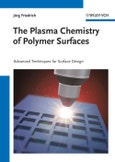More than 99% of all visible matter in the universe occurs as highly ionized gas plasma with high energy content. Electrical low- and atmospheric-pressure plasmas are characterized by continuous source of moderate quantities of energy or enthalpy transferred predominantly as kinetic energy of electrons. Therefore, such energetically unbalanced plasmas have low gas temperature but produce
sufficient energy for inelastic collisions with atoms and molecules in the gas phase, thus producing reactive species and photons, which are able to initiate all types of polymerizations or activate any surface of low reactive polymers. However, the broadly distributed energies in the plasma exceed partially the binding energies in polymers, thus initiating very often unselective reactions and polymer degradation. The intention of this book is to present new plasma processes and new plasma reactions of high selectivity and high yield.
This book aims to bridge classical and plasma chemistry, particularly focusing on polymer chemistry in the bulk and on the surface under
plasma exposure. The stability of surface functionalization and the qualitative and quantitative measurement of functional groups at polymer
surface are featured prominently, and chemical pathways for suppressing the undesirable side effects of plasma exposure are proposed
and illustrated with numerous examples. Special attention is paid to the smooth transition from inanimate polymer surfaces to modified bioactive polymer surfaces. A wide range of techniques, plasma types and applications are demonstrated.
sufficient energy for inelastic collisions with atoms and molecules in the gas phase, thus producing reactive species and photons, which are able to initiate all types of polymerizations or activate any surface of low reactive polymers. However, the broadly distributed energies in the plasma exceed partially the binding energies in polymers, thus initiating very often unselective reactions and polymer degradation. The intention of this book is to present new plasma processes and new plasma reactions of high selectivity and high yield.
This book aims to bridge classical and plasma chemistry, particularly focusing on polymer chemistry in the bulk and on the surface under
plasma exposure. The stability of surface functionalization and the qualitative and quantitative measurement of functional groups at polymer
surface are featured prominently, and chemical pathways for suppressing the undesirable side effects of plasma exposure are proposed
and illustrated with numerous examples. Special attention is paid to the smooth transition from inanimate polymer surfaces to modified bioactive polymer surfaces. A wide range of techniques, plasma types and applications are demonstrated.
Table of Contents
PREFACEINTRODUCTION
INTERACTION BETWEEN PLASMA AND POLYMERS
Special Features of Polymers
Processes on Polymer Surfaces during Plasma Exposure
Influence of Polymer Type
Methods, Systematic, and Definitions
Functional Groups and Their Interaction with Other Solids
PLASMA
Plasma State
Types of Low-Pressure Glow Discharges
Advantages and Disadvantages of Plasma Modifi cation of Polymer Surfaces
Energetic Situation in Low-Pressure Plasmas
Atmospheric and Thermal Plasmas for Polymer Processing
Polymer Characteristics
Chemically Active Species and Radiation
CHEMISTRY AND ENERGETICS IN CLASSIC AND PLASMA PROCESSES
Introduction of Plasma Species onto Polymer Surfaces
Oxidation by Plasma Fluorination and by Chemical Fluorination
Comparison of Plasma Exposure, Ionizing Irradiation, and Photo-oxidation of Polymers
KINETICS OF POLYMER SURFACE MODIFI CATION
Polymer Surface Functionalization
Polymer Surface Oxidation
Polymer Surface Functionalization with Amino Groups
Carbon Dioxide Plasmas
SH-Forming Plasmas
Fluorinating Plasmas
Chlorination
Polymer Modifi cation by Noble Gas Plasmas
BULK, ABLATIVE, AND SIDE REACTIONS
Changes in Supermolecular Structure of Polymers
Polymer Etching
Changes in Surface Topology
Plasma Susceptibility of Polymer Building Blocks
Plasma UV Irradiation
Absorption of Radiation by Polymers
Formation of Unsaturations
Formation of Macrocycles
Polymer Degradation and Supermolecular Structure of Polymers
Crosslinking versus Degradation of Molar Masses
Radicals and Auto-oxidation
Plasma-Induced Photo-oxidations of Polymers
Different Degradation Behavior of Polymers on Exposure to Oxygen Plasma
Derivatization of Functional Groups for XPS
METALLIZATION OF PLASMA-MODIFI ED POLYMERS
Background
Polymer Plasma Pretreatment for Well Adherent Metal -
Polymer Composites
New Adhesion Concept
Redox Reactions along the Interface
Influence of Metal?Polymer Interactions on Interface-Neighbored Polymer Interphases
Metal-Containing Plasma Polymers
Plasma-Initiated Deposition of Metal Layers
Inspection of Peeled Surfaces
Life Time of Plasma Activation
ACCELERATED PLASMA-AGING OF POLYMERS
Polymer Response to Long-Time Exposure to Plasmas
Hydrogen Plasma Exposure
Noble Gas Plasma Exposure, CASING
POLYMER SURFACE MODIFI CATIONS WITH MONOSORT FUNCTIONAL GROUPS
Various Ways of Producing Monosort Functional Groups at Polyolefi n Surfaces
Oxygen Plasma Exposure and Post-Plasma Chemical Treatment for Producing OH Groups
Post-Plasma Chemical Grafting of Molecules, Oligomers, or Polymers
Selective Plasma Bromination for Introduction of Monosort C -
Br Bonds to Polyolefi n Surfaces
Functionalization of Graphitic Surfaces
SiOx Deposition
Grafting onto Radical Sites
ATMOSPHERIC-PRESSURE PLASMAS
General
Dielectric Barrier Discharge (DBD) Treatment
Polymerization by Introduction of Gases, Vapors, or Aerosols into a DBD
Introduction of Polymer Molecules into the Atmospheric-Pressure Plasma and Their Deposition as Thin Polymer Films (Aerosol-DBD)
DBD Treatment of Polyolefi n Surfaces for Improving Adhesion in Metal?Polymer Composites
Electrospray Ionization (ESI) Technique
PLASMA POLYMERIZATION
Historical
General Intention and Applications
Mechanism of Plasma Polymerization
Plasma Polymerization in Adsorption Layer or Gas Phase
Side-Reactions
Quasi-hydrogen Plasma
Kinetic Models Based on Ionic Mechanism
Kinetic Models of Plasma-Polymer Layer Deposition Based on a Radical Mechanism
Dependence on Plasma Parameter
Structure of Plasma Polymers
Afterglow (Remote or Downstream) Plasmas
Powder Formation
Plasma Catalysis
Copolymerization in Continuous-Wave Plasma Mode
PULSED-PLASMA POLYMERIZATION
Introduction
Basics
Presented Work on Pulsed-Plasma Polymerization
Role of Monomers in Pulsed-Plasma Polymerization
Dark Reactions
Pressure-Pulsed Plasma
Differences between Radical and Pulsed-Plasma Polymerization
Surface Structure and Composition of Pulsed-Plasma Polymers
Plasma-Polymer Aging and Elimination of Radicals in Plasma Polymers
Functional Groups Carrying Plasma-Polymer Layers
Vacuum Ultraviolet (VUV) Induced Polymerization
Plasma-Initiated Copolymerization
Graft Polymerization
Grafting onto Functional Groups








